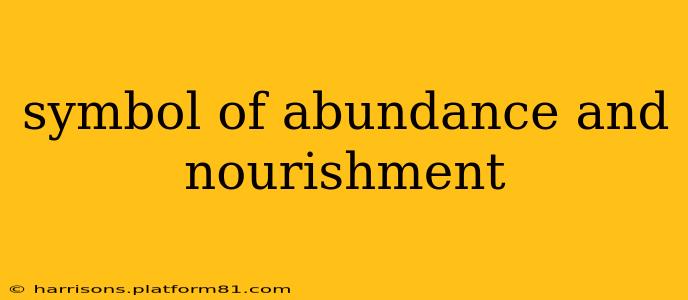Abundance and nourishment are fundamental human desires, reflected across cultures and throughout history in a diverse array of symbols. These symbols aren't merely decorative; they represent deep-seated hopes for prosperity, fertility, and the sustenance of life itself. This exploration delves into the rich tapestry of imagery associated with abundance and nourishment, examining their cultural significance and enduring power.
What are some common symbols of abundance and nourishment?
Many symbols represent abundance and nourishment, their specific meaning often nuanced by cultural context. Some of the most widely recognized include:
-
The Horn of Plenty (Cornucopia): This ancient symbol, often depicted as a overflowing horn filled with fruits, vegetables, and grains, represents an unending supply of food and prosperity. Its roots trace back to Greek mythology, where it was associated with the gods of fertility and abundance.
-
The Sun: The sun is a powerful symbol of life, energy, and growth, essential for the nourishment of all living things. Its association with warmth, light, and the life-giving process makes it a natural symbol of abundance.
-
Water: Essential for life, water represents cleansing, renewal, and the flow of abundance. Rivers, lakes, and oceans symbolize the continuous provision of nourishment and sustenance.
-
Fruits and Grains: These represent the bounty of the harvest and the fruits of labor. Specific fruits and grains may hold additional cultural significance; for example, wheat often symbolizes prosperity in Western cultures, while rice holds similar weight in East Asian cultures.
-
The Earth: As the source of all nourishment, the earth is a potent symbol of abundance and fertility. Its richness and capacity to provide sustenance are universally recognized.
What are the spiritual meanings of abundance symbols?
Beyond their literal representation of food and resources, symbols of abundance often hold deeper spiritual meaning. These meanings often relate to:
-
Prosperity: Not just material wealth, but also spiritual and emotional richness. Abundance symbols can inspire a sense of gratitude and contentment.
-
Fertility: The capacity to create, grow, and nurture life. This extends beyond literal reproduction to encompass creativity and personal growth.
-
Growth and Transformation: Abundance symbols can represent the cyclical nature of life, the continuous process of growth, and the potential for transformation.
-
Divine Favor: In many spiritual traditions, abundance is seen as a blessing from a higher power, a sign of favor and grace.
What are some examples of abundance symbols in different cultures?
The representation of abundance varies significantly across different cultures. Some examples include:
-
Lotus Flower (Eastern Cultures): The lotus flower, rising from muddy waters to bloom beautifully, symbolizes purity, enlightenment, and rebirth, all aspects linked to spiritual and material abundance.
-
Money Tree (Various Cultures): The money tree, often depicted with coins or currency growing from its branches, is a widely recognized symbol of financial prosperity and abundance.
-
Maneki-neko (Japanese Culture): This beckoning cat is believed to attract good luck and prosperity, a symbol of abundance and fortune.
-
Sacred Animals (Various Cultures): Animals such as the cow (India), the pig (some parts of Asia), and the ox (many cultures) are often associated with abundance due to their roles in agriculture and providing sustenance.
How can I use abundance symbols in my life?
Abundance symbols can be incorporated into daily life in various ways to cultivate a sense of prosperity and gratitude. This may include:
-
Artwork and Decoration: Displaying images of abundance symbols in your home or workspace can serve as a visual reminder of your goals and aspirations.
-
Jewelry and Talismans: Wearing jewelry featuring abundance symbols can be a personal affirmation of your desire for prosperity.
-
Meditation and Visualization: Visualizing yourself surrounded by abundance symbols during meditation can promote feelings of contentment and well-being.
-
Mindful Consumption: Practicing mindful consumption and appreciating the abundance in your life can foster gratitude and contentment.
By understanding and appreciating the diverse symbols of abundance and nourishment, we can tap into their power to inspire hope, gratitude, and a deeper connection with the natural world and our own inner resources. The significance of these symbols transcends cultures and time, serving as a timeless reminder of the importance of prosperity and sustenance in human life.
